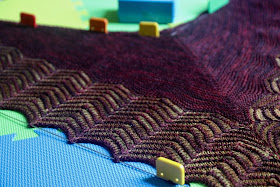The Summer of Shawls is going strong, and we've enjoyed seeing everyone's beautiful shawl projects shared during our photo contest. Today we're announcing the winners and sharing some new free patterns we've spotted recently to inspire your next knitting or crochet project!
Summer of Shawls Photo Contest Winners
We used the Random Number generator to select our winners:
Deluxe Ginger Interchangeable Set - Post #21 by Archey (and also shared with us on Instagram)
Ginger Tunisian Crochet Set - Post #11 by CarolMcq
Royale Special Interchangeable Set - Post #17 by sokker
Rainbow Knit Blockers - Post #25 by hjordisperkins
Shawl Inspiration: New Free Knitting & Crochet Patterns
There are plenty more inspiring projects to check out in our contest thread, and we also want to spotlight some of the latest FREE patterns to inspire your next project.
The Melon Ball Shawl by Erica Fedor is great for using up stash or showing off a gradient yarn. This quick-to-crochet pattern uses simple decreases and two basic stitches, making it ideal for newer crocheters!
For a more challenging crochet project, try Ozomene by Silke Terhorst. This triangle shawl uses fingering weight yarn to create an airy, lightweight shawl that's perfect for summer days.
Bethany Byman's Coachella Wrap adds a funky touch to any outfit and knits up quick in bulky yarn. This beginner-friendly pattern features an open stitch pattern and on-trend fringe to complete the look.
Fans of hand-dyed yarns will love the Linden Shawl by Lisa R. Myers. Play around with different color combinations with this easy-knitting shawl featuring a slipped-stitch motif and simple garter border.
Make sure to share your summer shawl projects with us using the #knitterspride and #kpshawlstyle hashtags. Happy knitting & crocheting!
Like this post? Pin it!
Summer of Shawls Photo Contest Winners
We used the Random Number generator to select our winners:
Deluxe Ginger Interchangeable Set - Post #21 by Archey (and also shared with us on Instagram)
 |
| View project details here. |
Ginger Tunisian Crochet Set - Post #11 by CarolMcq
 |
| View project details here. |
Royale Special Interchangeable Set - Post #17 by sokker
 |
| View project details here. |
Rainbow Knit Blockers - Post #25 by hjordisperkins
 |
| View project details here. |
Shawl Inspiration: New Free Knitting & Crochet Patterns
There are plenty more inspiring projects to check out in our contest thread, and we also want to spotlight some of the latest FREE patterns to inspire your next project.
The Melon Ball Shawl by Erica Fedor is great for using up stash or showing off a gradient yarn. This quick-to-crochet pattern uses simple decreases and two basic stitches, making it ideal for newer crocheters!
For a more challenging crochet project, try Ozomene by Silke Terhorst. This triangle shawl uses fingering weight yarn to create an airy, lightweight shawl that's perfect for summer days.
Bethany Byman's Coachella Wrap adds a funky touch to any outfit and knits up quick in bulky yarn. This beginner-friendly pattern features an open stitch pattern and on-trend fringe to complete the look.
Fans of hand-dyed yarns will love the Linden Shawl by Lisa R. Myers. Play around with different color combinations with this easy-knitting shawl featuring a slipped-stitch motif and simple garter border.
Make sure to share your summer shawl projects with us using the #knitterspride and #kpshawlstyle hashtags. Happy knitting & crocheting!
Like this post? Pin it!










